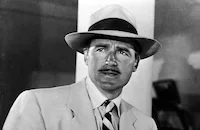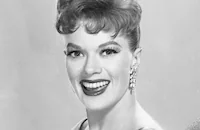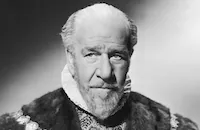Of Human Bondage

Brief Synopsis
Cast & Crew
Edmund Goulding
Paul Henreid
Eleanor Parker
Alexis Smith
Edmund Gwenn
Patric Knowles
Film Details
Technical Specs

Synopsis
In 1897, at the annual Artists' Ball in Paris' Latin Quarter, Philip Carey meets an American writer named Nora Nesbit, whom he tells that he has failed as an artist and intends to return to London to pursue medical studies. Blaming his clubfoot for his troubles, Philip also reveals that he has never been in love, but longs to be swept away by passion. One day, in London, a friend takes Philip to a tea shop to show him Mildred Rogers, the waitress with whom he is enamored.
Although Philip judges Mildred to be rude and vulgar, he is nonetheless strongly attracted to her and returns the following day to invite her to the theater. Mildred breaks their next date, making it clear to Philip that she is repulsed by him and in love with another man. Obsessed by thoughts of Mildred, Philip's studies suffer, and after several months, he returns to the tea shop to speak with her. There he learns that she has married Emil Miller, a traveling salesman. The news frees Philip of his obsession, and when he receives a letter from Nora, along with a copy of her new novel, he contacts her, and the two become close friends. Nora falls in love with Philip, but when a pregnant Mildred reappears in his life, having been abandoned by Miller, who has gone back to his real wife, Philip admits that he has only loved Mildred. After Mildred's baby is born, Philip offers to marry her and rear her child. Bored by Philip's somber approach to life, however, Mildred quickly takes up with his handsome, flirtatious fellow student, Harry Griffiths.
When Mildred spitefully proclaims that she will never marry Philip, he again leaves her and concentrates on his studies. One day, Athelny, a patient, asks Philip to his home for dinner. Soon Philip is a frequent visitor at the Athelnys', to the delight of Athelny's seventeen-year-old daughter Sally. This pleasant interlude ends when Philip encounters Mildred on the street, where she is working as a prostitute. He brings her and the baby home to live with him in exchange for housework. Although Mildred calls herself Mrs. Carey, Philip wants nothing to do with her, and when her attempts to seduce him fail, Mildred angrily burns his money and destroys his rooms. Meanwhile, Philip spends Christmas Eve with the Athelnys. Before he leaves, Philip gives Sally a necklace that belonged to his mother.
A distraught Philip then wanders the cold, rainy streets and later collapses with pneumonia at Harry's rooming house. Months later, Philip visits the Athelnys, not realizing that they have learned about Mildred and the baby and believe that he is married to her. When Philip understands why Athelny treats him coolly, he returns home, intending to commit suicide. Harry then takes him to the hospital where Mildred lies dying, her baby having already died. The way is now clear for Philip to propose to Sally, who has always loved him.

Director

Edmund Goulding
Cast

Paul Henreid

Eleanor Parker

Alexis Smith

Edmund Gwenn

Patric Knowles

Janis Paige

Henry Stephenson
Marten Lamont

Isobel Elsom

Una O'connor
Eva Moore
Richard Nugent

Doris Lloyd
Bill Kennedy
Jacqueline Milo
Maria Thunis
Yolanda Lacca
Jeanne Grandel
Nita Pike
Nina Bara
Christine Gordon
Kerry Vaughn
Gloria Stratton
Vivian Mason
Marilyn Buford
Mikki Saunders
Betty Price
Betty Dunston
Shelby Payne
Marjorie Walker
Angela Wilson
Herberta Williams
Rita Shore
Jeanne Lafayette
Elinor Troy
Charles Andre
Armand Roland
Alphonse Martel
Jacques Lory
Mayo Newhall
George Bruggerman
Gabriel Leonoff
Georges Renevant
Jean De Briac
George Davis
Joan Winfield
Bobby Hyatt
Jean Ransome
Mae Roberts
Phyllis Adair
Nigel Horton
Tony Marsh
Helena Grant
Luke Cosgrave
Harry Wilson
Sylvia Andrews
Connie Leon
Ada Ellis
Jean Prescott

Margaret Lee
Constance Gerard
Jane Blanton

Jo Ann Marlowe
Richard Glyn
Gregory Muradian
Betty Fairfax
Matthew Boulton
Donald Dewar
Colin Kenny
George Kirby
Bernard Deroux
Florence Wright
Crew
Gerald W. Alexander
Milo Anderson
James Bell
Henry Blanke
Paul Detlefsen
Leo F. Forbstein
Charles David Forrest
George James Hopkins
Stanley Jones
Harry Kelso
Clarence Kolster
Erich Wolfgang Korngold
Warren Lynch
Peverell Marley
William Mcgann
James Mcmahon
Max Parker
Hugh Reticker
Catherine Turney
Jack L. Warner
Robert G. Wayne
Perc Westmore

Videos
Movie Clip


Trailer
Film Details
Technical Specs

Articles
Of Human Bondage (1946)
Of Human Bondage had originally been filmed at RKO Pictures in 1934, with Davis performing on loan-out from her home studio, Warner Bros. That performance and picture were already legends in the '40s, when Warner's studio head Jack L. Warner decided to try another version of the tale of a young doctor obsessed with a low-class waitress. Hoping he could do for one of his contract stars what the first film had done for Davis, he decided to give the part of Mildred to the young Eleanor Parker, more known at the time for her sweet young leading lady roles. Ida Lupino, also under contract, would have been the perfect choice, as she was British and had triumphed with a similar role in The Light That Failed (1939), but she didn't want to be identified with British parts any more.
Director Edmund Goulding was far from convinced that Parker could handle the role, so he demanded three screen tests. After the second, he decided she could pull it off. To prepare, Parker studied the Cockney dialect with character actress Doris Lloyd, who played a minor role in the film. "I wrote every word out phonetically and memorized the role that way," Parker later remarked. Working with the wardrobe department, she pieced together a set of late 19th century costumes from what she would call the studio's "rag bag." She even agreed to play the role without makeup. Her transformation was so complete that British extras on the film thought she was the real thing, losing several bets when she revealed that she was just a small-town girl from Ohio. Unfortunately, a final death scene showing Parker ravaged by illness was considered too grim for audiences of that era and cut from the film. Another deleted segment was a heated sidewalk argument between Paul Henreid, Richard Nugent and Parker.
Yet, had the rest of the film come up to Parker's level, Of Human Bondage could have been a hit to rival the original. Unfortunately, the studio cut corners on casting, putting the Viennese actor Paul Henreid into the role of the young British doctor. They revised the novel's original storyline to give him an Austrian mother and put him in a blond wig to disguise his age, but it didn't really work. Nor did inserting dialogue at regular intervals about how young he was.
Yet in another way, Henreid helped the picture tremendously. The actor was concerned about Goulding's filming methods. The director would spend two days rehearsing a scene and then shoot it in one long take, which usually required going back and doing additional takes days later to add in close-ups and two-shots. When producer Henry Blanke was reluctant to confront Goulding on the issue, Henreid simply blew his lines whenever he thought a take was lasting too long. Goulding had to go back and pick the scene up from just before the mistake, which allowed Marley to switch the camera angle subtly.
Unfortunately, that wasn't enough. The film was finished in 1944, after which it had a disastrous preview screening. The long takes had destroyed the film's rhythm. Having learned about a new optical bench that allowed editors to create close-ups out of wider shots, Henreid suggested to his agent, Lew Wasserman, that they could re-edit the film. Wasserman suggested that the producer would be more receptive to suggestions from an agent than one of the stars, so Henreid stayed up all night marking close-ups and other shot changes in his script, then taught the changes to Wasserman. He, in turn, gave his notes to Blanke, who later called Henreid and said, "Paul, I've slept on this disaster, and I have some excellent ideas on how to salvage it. Trust me, I'll save the picture." Of course, he was unaware that Wasserman's suggestions had come from his leading man!
Due to a glut of product during the later years of World War II, Of Human Bondage sat on the shelf for two years, during which time it was cut further by the studio. Parker lost some of her best scenes, and Alexis Smith, though given co-star billing as the writer who almost saves Henreid from Parker's bad influence, was reduced to a supporting role. Despite some good reviews for Parker's performance, particularly in England, the picture was condemned by critics and ignored by the public. Worse yet, when MGM remade the story in 1964 (with Kim Novak and Laurence Harvey), the studio bought up Warner's 1946 version and withdrew it from television distribution until recently. Finally available for viewing again, Parker's performance compares favorably with Davis' and far overshadows Novak's interpretation of the part.
Producer: Henry Blanke
Director: Edmund Goulding
Screenplay: Catherine Turney
Based on the novel by W. Somerset Maugham
Cinematography: Peverell Marley
Art Direction: Hugh Reticker, Harry Kelso
Music: Erich Wolfgang Korngold
Principal Cast: Eleanor Parker (Mildred Rogers), Paul Henreid (Philip Carey), Alexis Smith (Nora Nesbitt), Edmund Gwenn (Athelny), Janis Paige (Sally Athelny), Patric Knowles (Griffiths), Henry Stephenson (Dr. Tyrrell), Isobel Elsom (Mrs. Athelny), Una O'Connor (Mrs. Foreman).
BW-106m. Closed captioning.
by Frank Miller

Of Human Bondage (1946)
Quotes
Trivia
Notes
Although "Mildred's" death is not attributed to a specific disease in this film, in the novel, she dies of tuberculosis. Somerset Maugham's novel was also the basis for the 1934 RKO film Of Human Bondage, which starred Bette Davis and Leslie Howard and was directed by John Cromwell (see AFI Catalog of Feature Films, 1931-40; F3.3201). In that version, "Mildred" was not allowed to be depicted as a prostitute, and "Philip's" clubfoot was surgically repaired before "Mildred" fell ill. In 1964, a British version of the novel was filmed, which starred Kim Novak and Laurence Harvey.















